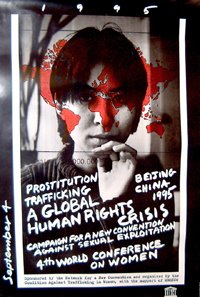Sunday, October 01, 2006
Opposing Prostitution As a Form of Male Violence: the Swedish Model
 Right: Artist Mona Mark created this poster for the Coalition Against Trafficking in Women for the Fourth World Conference on Women, Beijing, 1995. Image source: Prostitution Research & Education.
Right: Artist Mona Mark created this poster for the Coalition Against Trafficking in Women for the Fourth World Conference on Women, Beijing, 1995. Image source: Prostitution Research & Education.From the old news department comes an article in the June-July 2005 issue of the American Friends Service Committee's Peacework Magazine. Below is an opening excerpt from "Opposing Prostitution As a Form of Male Violence: the Swedish Model" by Marie De Santis, director of the Women's Justice Center/Centro de Justicia Para Mujeres.
In the fog of clichés despairing that "prostitution will always be with us," one country's success stands out as a beacon lighting the way. In just five years Sweden has dramatically reduced the number of women in prostitution. In the capital city of Stockholm, the number of women in street prostitution has been reduced by two thirds, and the number of "johns" has been reduced by 80%. There are other major Swedish cities where street prostitution has all but disappeared. Gone too, for the most part, are the infamous Swedish brothels and massage parlors which proliferated during the last three decades of the twentieth century, when prostitution in Sweden was legal.Read the rest of the article here.
In addition, the number of foreign women now being trafficked into Sweden for sex work is almost nil. The Swedish government estimates that in the last few years only 200 to 400 women and girls have been annually sex trafficked into Sweden, a figure that's negligible compared to the 15,000 to 17,000 females yearly sex trafficked into neighboring Finland. No other country, nor any other social experiment, has come anywhere near Sweden's promising results.
By what complex formula has Sweden managed this feat? Amazingly, Sweden's strategy isn't complex at all. Its tenets, in fact, seem so simple and so firmly anchored in common sense as to immediately spark the question, "Why hasn't anyone tried this before?"
Sweden's Groundbreaking 1999 Legislation
In 1999, after years of research and study, Sweden passed legislation that a) criminalizes the buying of sex, and b) decriminalizes the selling of sex. The novel rationale behind this legislation is clearly stated in the government's literature on the law:
"In Sweden prostitution is regarded as an aspect of male violence against women and children. It is officially acknowledged as a form of exploitation of women and children and constitutes a significant social problem ... gender equality will remain unattainable so long as men buy, sell, and exploit women and children by prostituting them."
In addition to the two-pronged legal strategy, a third and essential element of Sweden's prostitution legislation provides for ample and comprehensive social service funds aimed at helping any prostitute who wants to get out, and additional funds to educate the public. As such, Sweden's unique strategy treats prostitution as a form of violence against women in which the men who exploit by buying sex are criminalized, the mostly female prostitutes are treated as victims who need help, and the public is educated in order to counteract the historical male bias that has long stultified thinking on prostitution. To securely anchor their view in firm legal ground, Sweden's prostitution legislation was passed as part and parcel of the country's 1999 omnibus violence against women legislation.
Labels: gender, prostitution, violence




